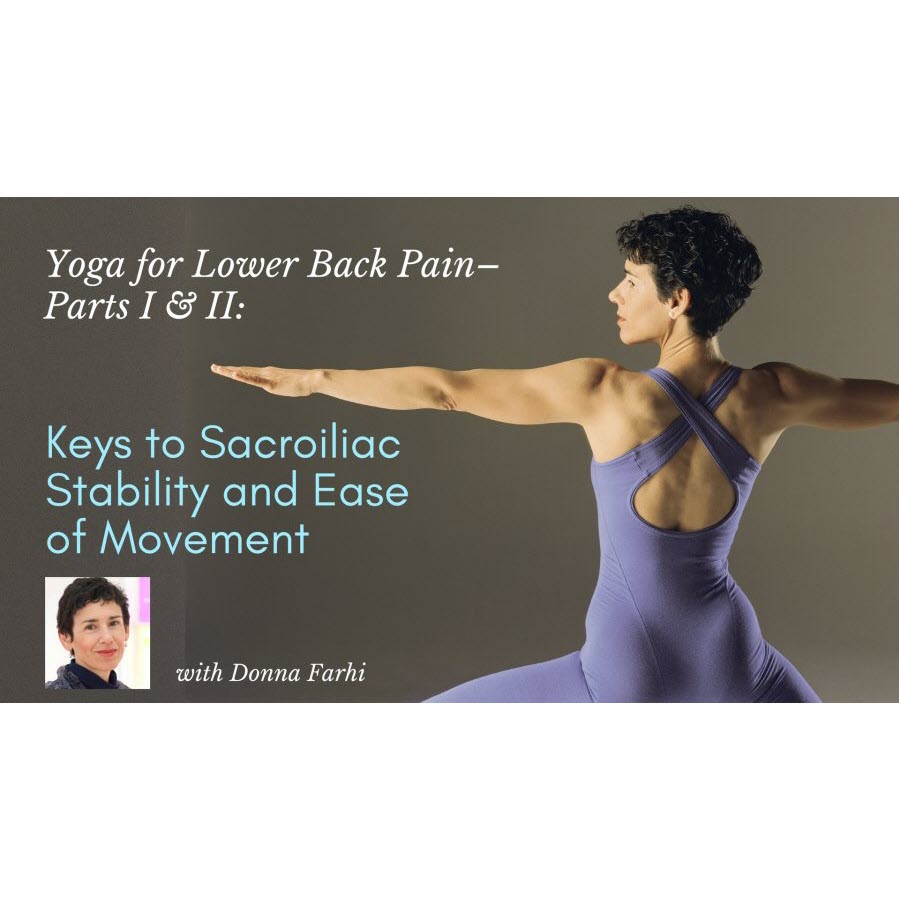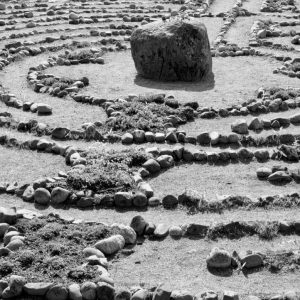Subtotal: $5.95
Yoga for Lower Back Pain: Keys to Sacroiliac Stability and Ease of Movement
$397.00
This course provides detailed and highly relevant teaching that qualifies for 13 non-contact hour CEU’s with Yoga Alliance or 13 APD Hours with the International Association of Yoga Therapists.
More and more Yoga practitioners (and teachers) are showing up to class with debilitating sacroiliac discomfort becoming members of a rapidly growing international “SI Club.” In many instances, SIJ issues in Yoga practitioners are the consequence of repetitive dysfunctional movements, skewed body mechanics and forceful overstretching. Little by little, these actions can erode the inherent stability of the pelvis, resulting in pain and movement impairment. This course will be an invaluable investment in helping you to prevent and resolve sacroiliac instability for yourself and your students. In this 8-part course, Donna will guide you through the complex anatomy and kinesiology of the sacroiliac joints so that you can better understand why certain practices compromise the integrity of these joints. Drawing on decades of medical research, we’ll look at several models for joint function and spinal stability that can inform your movement choices, and better enable you to adapt the method or tradition of Yoga you practice. Donna has been leading sacroiliac courses for Yoga students and teachers for over a decade. In April 2017, as a result of a horse-riding accident, she broke her pelvis in two places causing debilitating pelvic instability. Her explorations during months of therapeutic Yoga practice and movement work, has deepened her understanding of the importance of working in progressive stages to first alleviate pain, regain symmetry, stability and strength, and gradually restore multi-dimensional movement crucial for everyday activities. The discoveries she is making from her own recovery now inform her work in helping others to restore pelvic stability.
Part One
- Lectures 1 and 2: Anatomy of the Sacroiliac Joints covering the history of the SIJ, its relationship to the lumbar spine and hips, and the specific anatomical features that contribute to its stability bias yet paradoxically also allow for small degrees of mobility essential for optimal movement. We’ll look at how gender differences can make females more prone to SIJ issues, and how variation in pelvic, sacral, hip and femur structure can create implicit limits for some individuals. Finally, we’ll investigate how unsound biomechanics can leverage into and pry apart these joints setting the stage of SIJ misalignment.
- Video: Eight Things Yogis Do to Stuff-Up Their SI-Joints: Including femoral and spinal leveraging, misguided biomechanics in standing postures, faulty transitions in flow sequences, and poor core strength coupled with hypermobility. Discontinuing these common practices can radically alter the future outcome your sacroiliac joints, hips and lower back.
- Video: Reducing Pain & Discomfort: Research shows that pain alone can contribute to ongoing poor motor control and movement dsyfunction. You’ll learn a simple practice sequence for calming and alleviating sacroiliac discomfort and helping to recenter the pelvic bones. We’ll do targeted release work with the iliopsoas muscles, gently mobilize the pelvis and lumbar spine, and learn to adapt practices to prevent excessive loading into the SIJs. We’ll also look at prop considerations that can make a big difference for those with pelvic discomfort.
Part Two:
- Lectures 3 and 4: Kinesiology of the Sacroiliac Joint & Model’s for Optimal Movement Function covering the historical development of Panjabi’s Spinal Stability System, Vleeming and Lee’s Integrated model for joint function and Hoffman & Gabels’ “Stability to Express Movement” theorem. These models give us a platform to understand why optimal movement cannot be attained through isolated core strength alone. Startling new meta-analysis studies are revealing that training stability in isolation does not offer long-term relief in people with lower back pain. We’ll look at how stability and mobility systems of the skeleton and ligaments, muscles, fascia and tendons, and the coordination of movement through the nervous system form an interdependent relationship. Building on this we’ll investigate the intimate relationship between the “mobility-designed” hip joint, and the “stability-designed” sacroiliac joint and how these structures can be affected by common yet misguided alignment cues and “hip-opening” strategies. By understanding the movements of nutation, counternutation, and the unique action that twisting has on the SIJs, we’ll build a protocol for recovery of movement function starting with the safest movements, building towards more challenging but necessary movements, and identifying the movements most challenging to the SIJs (that may have limited usefulness for everyday living).
- Video: Coming Together: Building Pelvic Integrity – This practice protocol focuses on reducing asymmetrical torque in the SIJs caused by muscular imbalances, and progresses towards strengthening both core and global body tone and movement coordination to stabilize the pelvis and reduce SIJ joint translation. Many people who suffer from chronic or intermittent SIJ discomfort falsely believe that further stretching will alleviate their discomfort, only to discover that within hours the pain has worsened. Although counterintuitive, increasing force closure of the SIJs (the snugness of the joint offered through increased regional muscular support) can give startlingly positive results, both immediately after practice, and in the long term. Donna will also share some unique sequences she has developed that have radically improved her pelvic stability and improved the depth of stance, speed and balance of walking (an activity that for many people exacerbates their SIJ discomfort). This pelvic integrity practice is a simple, accessible practice that may become your lifelong friend.
- Video: Maintaining Stability While Regaining Mobility – Restoring pelvic stability often involves limiting practice to linear, sagittal planes of movement and, for a period of time, avoiding movements that challenge SIJ stability. Our everyday activities, however, require that we be able to move safely and effectively in multiple planes—rotating, spiraling, changing levels, and using our limbs in an asymmetrical fashion. This practice sequence begins with a standing warming and loosening sequence to improve fluidity in the spine. We’ll then explore strategies for maintaining stability while increasing mobility and function: reintroducing asymmetrical practices such as lunges, wide-stance standing postures, and twists. Many of the variations offered can be incorporated into your Yoga classes to help your students avoid future SIJ problems.
This Premium Course Also Includes These Bonuses!
- Recordings of All Sessions: Yours to keep. It’s generally acknowledged that many people only retain 10-20 percent of what they learn in a workshop. You will get access to the recordings of both sessions, enabling you to go back and listen to the workshop as many times as you like.
- Transcripts of All Sessions: Ever wanted to refer to a certain part of a course? Even the best note takers miss a point every so often. With the transcripts of the webinar sessions, you can go back and refer to particularly important passages or clarify sections you were in doubt about.
- Four Yoga Practice Guides: These extremely handy “cheat sheets” outline the major instructional components from each of the yoga practice videos in this course. After watching the videos, you can refer to these guides for the main points and visuals of each posture as you work through or guide others through the practices.
Suggested Four Week Learning Schedule:
Week 1:
- Develop a comprehensive understanding of the bones, ligaments, and articulating surfaces of the pelvis and lower spine
- Explore the natural range of motion for both the SI joint and spinal facets Identify observed gender differences in the anatomy of this region
- Understand how force is transmitted through the pelvis
- Video: Eight Things Yogis Do to Stuff-Up Their SI-Joints: Including femoral and spinal leveraging, misguided biomechanics in standing postures, faulty transitions in flow sequences, and poor core strength coupled with hypermobility.
Week 2:
- Understand the key types of Sacroiliac dysfunction and common habits that can aggravate these
- Learn the three levers we exert on our SI joints
- Explore how these forms of leveraging can show up in yoga practice and what problems they can cause
- Develop a toolset for identifying sacroiliac dysfunction and steps to take to mitigate it
- Video: Reducing Pain & Discomfort: Learn a simple practice sequence for calming and alleviating sacroiliac discomfort and helping to recenter the pelvic bones. Do targeted release work with the iliopsoas muscles, gently mobilize the pelvis and lumbar spine, and adapt practices to prevent excessive loading into the SIJs.
Week 3:
- Build a comprehensive understanding of the musculature and kinesiology of the pelvis and lower spine
- Explore the 3 stability and 3 mobility subsystems of the musculoskeletal and nervous systems and how to put their principles into practice
- Identify common “problem” poses
- Video: Coming Together: Building Pelvic Integrity: Learn a protocol to reduce asymmetrical torque in the SIJs. Many people who suffer from SIJ discomfort falsely believe that stretching will alleviate their discomfort, only to discover that within hours the pain has worsened. Although counterintuitive, increasing force closure of the SIJs (the snugness of the joint offered through increased regional muscular support) can give startlingly positive results, both immediately after practice, and in the long term. This pelvic integrity practice is a simple, accessible practice that may become your lifelong friend.
Week 4:
- Develop a step-by-step progression for working with sacroiliac dysfunction
- Identify a spectrum of pose types from safest to least safe
- Common adjusting “no-no”s to avoid
- Video: Maintaining Stability While Regaining Mobility: This practice sequence begins with a standing warming and loosening sequence to improve fluidity in the spine. Explore strategies for maintaining stability while increasing mobility and function, reintroducing asymmetrical practices such as lunges, wide-stance standing postures, and twists. Many of the variations offered can be incorporated into your Yoga classes to help your students avoid future SIJ problems.
This course qualifies for 13 non-contact hour CEUs with Yoga Alliance.

 Pathways to a Centered Body - Companion Video (Download not a DVD)
Pathways to a Centered Body - Companion Video (Download not a DVD) 


